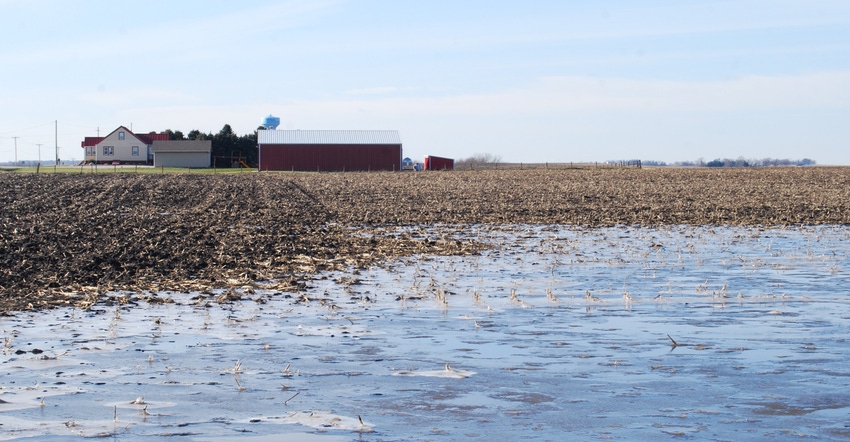April 24, 2019

If planting is delayed due to flooding or wet fields, what are your options with crop insurance? USDA’s Risk Management Agency has rules that crop insurance companies and insured farmers must follow. “But you do have some options,” says Doug Burns, vice president of regional services for Farm Credit Services of America, based at Perry, Iowa.
One thing farmers who have crop insurance need to do is contact their crop insurance agent within 72 hours of when they finish planting their 2019 crop. The latest you can plant and still be fully covered by crop insurance is May 31 for corn and June 15 for soybeans.
If you are past that date and still planting, you can continue to plant the intended crop during what is called “the late planting period.” That’s typically 25 days after the May 31 and June 15 deadlines. You can plant into that late planting period and the reduction in coverage for the insured crop is 1% for every day you continue to plant, Burns says.
Filing for prevented planting
You can choose to not plant into the 25-day late planting period, he adds. Thus, you would file for “prevented planting” with your crop insurance agent if your policy offers that provision.
Prevented planting must be due to an insured cause of loss that is general in the surrounding area and that prevents other producers from planting acreage with similar characteristics. Failure to plant when others in the area were able to plant could result in denial of the prevented planting claim.
If you can’t get the corn or soybeans planted, you can plant a cover crop if you choose to do so, says Burns, or you can idle the ground. Either way, make sure you know your options. You can continue to plant, you can switch crops (plant soybeans instead of corn intended for a field) or you can take prevented planting.
“If you are prevented from planting, be sure to take pictures of the field,” he advises. “Photos are date-stamped, and if companies get backlogged on insurance claims, having photos can help the process.”
Other requirements to qualify
Another requirement to qualify for a prevented planting claim is the 20/20 rule. If you have at least 20 acres or 20% of the unit remaining to plant, you could be eligible for a prevented planting indemnity payment. Also, to be eligible for prevented planting, that land must have been planted in at least one of the four most recent years.
This is for land that’s insured using the enterprise unit option, Burns says. You have to plant in two sections to get the enterprise unit discount on the premium you pay for crop insurance. Sometimes, if you have prevented planting, it could knock you out of an enterprise unit if you don’t plant in two sections.
If you take prevented planting and don’t plant a row crop on that acreage, you can plant a cover crop or just leave those acres idle. “You can plant a cover crop for conservation purposes,” Burns says. “We encourage you to contact your local NRCS office to get information on appropriate seeding rates and species and related recommendations for your area.”
If you plan to plant a cover crop on prevented planting acres and use it for hay or grazing, keep in mind you can’t hay or graze it before Nov. 1 or it affects the prevented planting claim payment.
Flooded grain bins
Another question some farmers have this spring concerns flooding of bins holding stored grain. Crop insurance doesn’t cover stored grain. Recently, USDA announced it doesn’t have authority to include stored grain in the disaster programs.
“Unfortunately, it’s a difficult predicament. If the stored grain has had water in it from a flooded river or stream, it’s considered adulterated according to federal regulations, and the grain must be destroyed. It can’t be fed or sold,” Burns says.
The website FCSAmerica.com has answers to frequently asked questions about prevented planting, replanting and late planting. It also has information on disaster assistance loans.
Disaster assistance loans
Producers impacted by flooding may need to look at the lending side of FCSAmerica. “We have a disaster assistance loan program,” Burns says. “We can work directly with our loan customers to identify their immediate and long-term financial needs. Our goal is to provide crop insurance expertise, and flexible loan terms that are customized to fit the producer’s needs.”
Contact any of the FCSAmerica retail offices, call 800-884-FARM or visit the website for crop insurance and farm loan information.
About the Author(s)
You May Also Like






